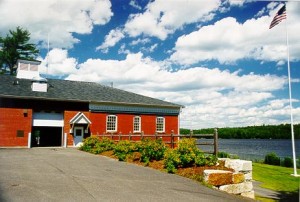Water Source and Treatment

Nequasset Lake
For over 100 years, the 21-square-mile watershed of Nequasset Lake has been Bath Water District’s source of supply. The majority of Nequasset watershed lies in the Town of Woolwich , but extends into the neighboring towns of Dresden and Wiscasset. High-quality drinking water supplies are hard to find in coastal Maine . As the only major lake in the area, Nequasset Lake is relied upon to provide both drinking water and recreational activities to the region.
Protecting Our Source
BWD owns approximately 370 acres of watershed land, only a small fraction of the 21 square miles that make up the entire watershed. BWD does, however, own roughly seventy percent of the shoreline around the lake and restricts activities that could potentially contaminate the water within this zone. BWD participates in frequent lake and foot patrols within the watershed. Swimming is prohibited, except at the south end of the lake near the state boat launch area. The use of boats with motors larger than 10 hp is also forbidden.
The Treatment Process
Water flows from Nequasset Lake into BWD’s treatment plant, where multiple treatment processes, including filtration and disinfection, are used to remove particles and microorganisms. The Microfloc filtration system was designed specifically for the water characteristics of Nequasset Lake.
Intake: Water is withdrawn from the lake through two intakes. Logs, fish, and plants are screened out at the intake.
Coagulation and Flocculation: Chemicals are added to the water to help group suspended particles together so they can be easily filtered. This process is known as coagulation and flocculation. Chemically treated water is mixed to ensure that it is uniformly treated.
Clarification: After the water has undergone coagulation and flocculation it is ready to be put through the clarifiers. the clarifiers remove large particles in preparation for filtration.
Filtration: Filtering removes pathogens(giardia, cryptosporidium, etc.), organic materials and suspended solids. the filters consist of several layers of granular media that remove small particles.
Disinfection/chemical treatment: Chlorine and a small amount of ammonia are added to kill any harmful protozoa, bacteria or viruses that are not removed by the filters. Sodium hydroxide and polyphosphate are added to maintain the proper pH and condition the water for the distribution system. Fluoride is added to prevent tooth decay.
Clearwell Storage: Treated water is pumped out of the 126,000 gallon storage tank, called the clearwell, into the system by three 150hp pumps.
Storage and Distribution: Water travels to the system through two 16 inch transmission mains. These lines pass under the Kennebec River to 60 miles of distribution main and two storage tanks. The distribution system provides a method of getting water from the treatment plant to customers, allows for additional water treatment, and provides fire protection capacity. Customers are connected to the distribution system via individual service lines.
For more in depth information on the treatment process please click the link to our Consumer Confidence Report on the home page.




